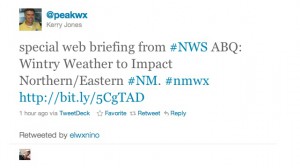Three interesting case studies this week in the use of social media in my journalism (or in one case just my life), which I hope might be of some interest to others (especially colleagues who have been skeptical of its utility – you know who you are).
 New Mexico had a historic storm this week, a freeway-clogging, school-closing, pipe-freezing, gas-service-interrupting mess. One of my jobs at the newspaper is to pay attention to the weather and explain/warn as needed. I could not have done that, or done it as well, without Twitter.
New Mexico had a historic storm this week, a freeway-clogging, school-closing, pipe-freezing, gas-service-interrupting mess. One of my jobs at the newspaper is to pay attention to the weather and explain/warn as needed. I could not have done that, or done it as well, without Twitter.
Every newsroom I’ve worked in over the decades has had, as its soundtrack, the chatter of a police scanner. We know how to use that – quick bursts of information, often unconfirmed, that are worth paying attention to in a low level, background way.
My Twitter feed is like that, but on a broad range of topics. It includes, for example, a number of people working at the National Weather Service’s Albuquerque office, who do a great job of sending out links to their latest forecast information, interesting data, and a heads up when the weather is about to get interesting. (That’s Kerry Jones and Daniel Porter you see in the accompanying picture, passing along a link to Daniel’s latest storm update.) My feed also includes other journalists, emergency services folks (both agency and individual feeds) and a lot of regular people who live around New Mexico. When an event like our epic cold happens, the chatter picks up, creating an ambient awareness of the developing situation – tidbits to check out, alerts from government officials, journalists linking to their latest info, people asking questions, other people giving answers.
There is, for example, Melwell Romancito up in Taos, where the gas has been off for more than 48 hours. I have no idea who she is, but people started Retweeting her stuff, I followed her, and she’s become a great source of information. (She just pointed out a problem with some info that’s currently making the rounds from an earlier gas company release. Turns out we still have that info on the newspaper’s web site. Must get it fixed.) Or TaosJohn, who shared a link to the Taos Police Department Facebook page. There also are official channels, like the New Mexico public safety folks.
This is the sort of ongoing, rapid fire communication that has always gone on in a story like this – trying to reach out and communicate as quickly as possible with a range of people who might have relevant information. Twitter is simply a huge force multiplier.
The second case study is far simpler and less freighted, but has a lot of similarities.
I don’t write much directly about economics, but it is an important boundary condition for a lot of what I cover – water policy, energy, environmental issues. So I try to have a sort of ongoing ambient awareness about what’s going on in the economy, to help me understand when I need to dive into in more detail. My Twitter feed includes a list of economists and economics journalists (and probably some people who are both) that acts as a sort of police scanner for the economy. When Friday’s confusing set of jobs/unemployment numbers came out, I didn’t have the time or the expertise to sort it out myself. But that was OK, because the people I follow on Twitter did it for me in a 24-hour burst of shared links – first alerting me to the data release, then taking me through the sorting out they were all doing.
Again, this is the sort of thing I could have done (and often still do) in other ways – hunting through the econ blogs and work of various journalists or diving into the data myself. Twitter made it far easier and more serendipitous.
There are a lot of other subject areas like these – New Mexico politics and the state legislature, climate science and politics, energy policy, western water – where a carefully assembled Twitter feed of smart people chatting about what they know is an incredibly useful way of tracking what’s going on. Having the equivalent of a police scanner for the water policy beat is awesome.
In the previous cases, I am my own “curator”, picking which feeds to follow, getting a feel for who to listen to and how. The previous cases also relate directly to my job. The final case study is Egypt, where I’ve joined 39,414 other twitter users (as of 8:27 p.m. MST Saturday) and outsourced the curation to Andy Carvin. Amy Gahran at Knight Digital Media explains a bit about who Carvin is (NPR “senior strategist”, whatever that means) and how he’s doing it. The bottom line is that he’s find and sharing information at an amazingly rapid fire and amazingly useful rate.
Plus, there’s ro_bot_dylan.

Pingback: Tweets that mention Social Media and the Journalist’s Toolkit : jfleck at inkstain -- Topsy.com